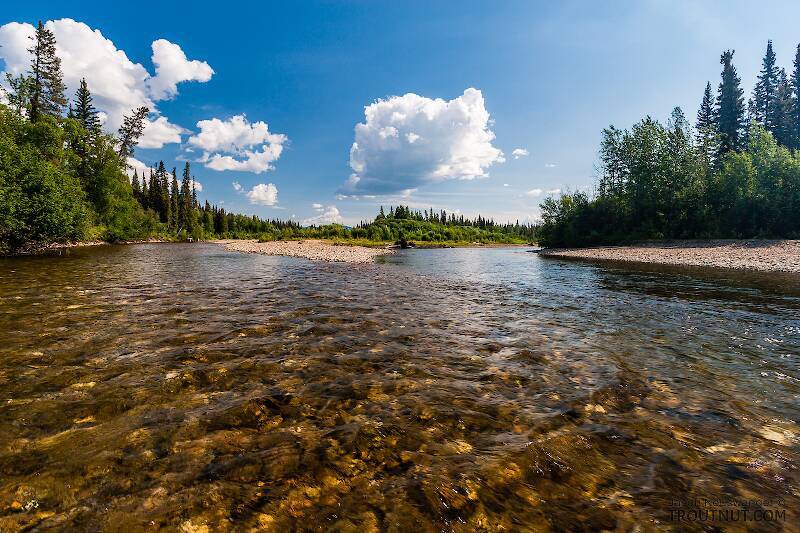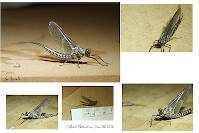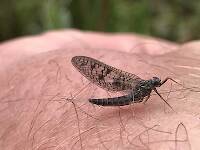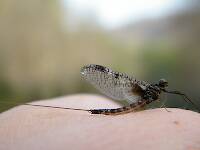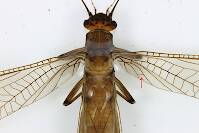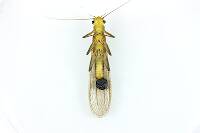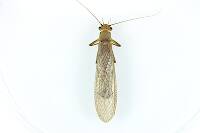
Salmonflies
Pteronarcys californica
The giant Salmonflies of the Western mountains are legendary for their proclivity to elicit consistent dry-fly action and ferocious strikes.
Featured on the forum

This specimen keys pretty easily to Onocosmoecus, and it closely resembles a specimen from Alaska which caddis expert Dave Ruiter recognized as this genus. As with that specimen, the only species in the genus documented in this area is Onocosmoecus unicolor, but Dave suggested for that specimen that there might be multiple not-yet-distinguished species under the unicolor umbrella and it would be best to stick with the genus-level ID. I'm doing the same for this one.

Troutnut is a project started in 2003 by salmonid ecologist Jason "Troutnut" Neuswanger to help anglers and
fly tyers unabashedly embrace the entomological side of the sport. Learn more about Troutnut or
support the project for an enhanced experience here.
MItroutbum
Posts: 3
Posts: 3
MItroutbum on Jun 19, 2008June 19th, 2008, 11:41 am EDT
What can I look for to distinguish between the 2 above mentioned flies?? I was out fishing yesterday evening and captured what I thought was a gray drake spinner, but after searching through some photos it could very easily be a Great Speckled Olive. I actually posted a photo on my fishing blog (not a great shot at all, but maybe you guys could help me out......
http://troutonthefly.blogspot.com/
Thanks
Rich
http://troutonthefly.blogspot.com/
Thanks
Rich
GONZO on Jun 19, 2008June 19th, 2008, 12:31 pm EDT
Rich,
The photo on your website looks like Siphlonurus to me. One fairly easy way to verify this would be to use a hand lens to look at the leading edge of the forewing toward the tip. Siphloplecton will have a jumble of intersecting cross-veins (anastomosis). In addition, Siphloplecton basale is usually an April/May emerger.
The photo on your website looks like Siphlonurus to me. One fairly easy way to verify this would be to use a hand lens to look at the leading edge of the forewing toward the tip. Siphloplecton will have a jumble of intersecting cross-veins (anastomosis). In addition, Siphloplecton basale is usually an April/May emerger.
Wiflyfisher on Jun 20, 2008June 20th, 2008, 12:25 am EDT
The photo labeled "Gray Drake Spinner" looks like a March Brown (M. vicarium) spinner to me and the timing would be right too.
It looks like you had a great UP trip!
It looks like you had a great UP trip!
John S.
https://WiFlyFisher.com
https://WiFlyFisher.com
Freepow on Jun 20, 2008June 20th, 2008, 3:40 am EDT
Great blog! I really like the format and the style it has. I too agree that the pic looks like a March Brown to me. I posted this pic...
http://www.troutnut.com/topic/1450#9507
...which was quickly determined to be March Brown and it looks very similar to your mayfly. I've bookmarked your blog...keep up the good stories.
http://www.troutnut.com/topic/1450#9507
...which was quickly determined to be March Brown and it looks very similar to your mayfly. I've bookmarked your blog...keep up the good stories.
"I fish...because I suspect that men are going along this way for the last time, and I for one don't want to waste the trip..."
GONZO on Jun 20, 2008June 20th, 2008, 5:45 am EDT
Rich,
I just realized that I could enlarge the image on your website by clicking on the picture. In the enlarged image, these traits of (some) Siphlonurus become more distinct:
The banding of the eye, which was not obvious in the smaller image, can be seen. (Live specimens usually show this more clearly.)
The "zigzag" pattern of banding on the tergites is more apparent (especially on the last few segments).
The cross-veins along the leading edge of the forewing are pale or nearly transparent. (This is not a consistent trait of all Siphlonurus, but on M. vicarium, they are dark.) Veinlets connecting CuA to the rear margin of the forewing can be seen.
BTW, regarding your original question, I probably should have mentioned that S. basale also shows dark staining toward the wingtips (in the same area where anastomosis would appear) and on the basal third of the hindwings. Jason has a good photo of a basale spinner that shows this staining and anastomosis.
I just realized that I could enlarge the image on your website by clicking on the picture. In the enlarged image, these traits of (some) Siphlonurus become more distinct:
The banding of the eye, which was not obvious in the smaller image, can be seen. (Live specimens usually show this more clearly.)
The "zigzag" pattern of banding on the tergites is more apparent (especially on the last few segments).
The cross-veins along the leading edge of the forewing are pale or nearly transparent. (This is not a consistent trait of all Siphlonurus, but on M. vicarium, they are dark.) Veinlets connecting CuA to the rear margin of the forewing can be seen.
BTW, regarding your original question, I probably should have mentioned that S. basale also shows dark staining toward the wingtips (in the same area where anastomosis would appear) and on the basal third of the hindwings. Jason has a good photo of a basale spinner that shows this staining and anastomosis.
Wiflyfisher on Jun 20, 2008June 20th, 2008, 10:35 am EDT
Gonzo, doesn't Siphlonurus spinners have a white band around the base of the eyes? Everyone I have ever collected over the years in NW WI. had the white ring around the base of each eye.
John S.
https://WiFlyFisher.com
https://WiFlyFisher.com
GONZO on Jun 20, 2008June 20th, 2008, 11:02 am EDT
Yes, John, that light band is usually quite prominent on the males. However, the band can be seen on the enlargement. I suspect that the band might be less distinct because the spinner appears to be dead, or perhaps it is just the lighting in the photo.
Quick Reply
Related Discussions
Topic
Replies
Last Reply
4
Jun 17, 2020
by Leskorcala
by Leskorcala
9
Jun 17, 2015
by Oldredbarn
by Oldredbarn
6
Jun 10, 2009
by Martinlf
by Martinlf

